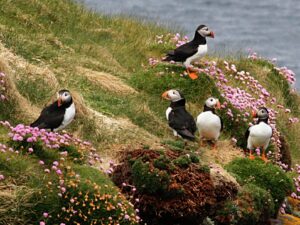In the Andaman archipelago, in the Bay of Bengal, lies North Sentinel Island. The indigenous inhabitants, the Sentinelese, refuse contact with the outside world. Their voluntary isolation and hostility towards those keen to step foot on their shores have ensured that this Indian island remains mysterious.
Meeting one of the world’s last unconnected tribes is a dangerous undertaking.
History
We have little information on North Sentinel’s history, but historians suggest that the islanders might have originally migrated from Africa. They have a hunter-gatherer culture and eat mainly seafood to survive. They do not seem to practice agricultural or farming techniques. Aerial surveys found that they live in small huts and they use rudimentary boats to hunt on the reef.
As of 2018, the Indian government estimates a population of almost 40. However, some sources claim there are around 100. From the very few encounters and photographs we have, the Sentinelese are short, muscular, and have very dark skin. They are usually naked but wear belts on their waists. There are more men than women.
Marco Polo mentioned the Andaman Islands in his writings, he passed them on his way to India. Though he didn’t write of North Sentinel specifically, he refers to people in the Andaman Islands as having “heads like dogs, and teeth and eyes like dogs.” He also claimed the Andaman people were cannibals.

The Sentinelese on the beach. Photo: Outlook India
Sentilese culture and language are a mystery. Some speculate that Sentinelese could be a branch of the wider Andamanese language family, which seems to have links to Papuan languages. However, other Andaman tribes who met the Sentinelese could not understand them.
As for their cultural practices, we have no information.
Meetings with outsiders
Interest in the island and its inhabitants dates back to the 18th century. However, at the time, no one set foot there. It wasn’t until the 19th century that outsiders got up close and personal. In 1867, the ship Nineveh had the misfortune of wrecking too close to the island. The Sentinelese tried to kill the survivors who were thankfully rescued in the nick of time.
In 1880, British naval officer Maurice Vidal Portman, who made contact with and studied various tribes throughout the Andaman Islands, met with the Sentinelese and even brought a few of the natives to the capital, Port Blair. Unfortunately, two of the group of six Sentinelese died from disease. The rest returned home before things got worse.
Another shipwreck occurred in 1981. The Primrose almost had a deadly encounter with the Sentinelese. The captain radioed for help, describing the attackers as “wild men…carrying homemade weapons.”
Despite these negative meetings, the Sentinelese allowed a team of anthropologists to meet them on the shore of the island in the early 1990s. The team offered them coconuts as a gesture of peace. During their meeting, the anthropologists noticed that the Sentinelese were fascinated by metal objects. Yet, any goodwill was short-lived, the Sentinelese deterred any subsequent expeditions.

Sentinelese hunting. Photo: Ujjwal
In 2006, the Sentinelese killed two fishermen who were fishing in North Sentinel’s waters illegally. In 2018, they killed American Christian missionary John Allen Chau when he tried to visit the island to spread Christianity.
The bodies of the three individuals are still on North Sentinel. A witness who transported Chau stated that Chau’s body was buried on the beach.
Geography
The only way to get a good look at North Sentinel Island is by plane. As you fly over the forbidden territory, you see a picturesque tropical island with lush forests, pristine blue waters, and coral reefs. The island is only 60km2. Its twin, South Sentinel Island, has no inhabitants and it is unclear if the residents of North Sentinel travel there.
North Sentinel changed after the 2004 Indian Ocean earthquake. The quake lifted the island out of the water by a couple of meters and resulted in a small nearby islet joining the main island.
After the earthquake and subsequent tsunami, the Indian government sent a helicopter to check on the islanders. To their surprise, the Sentinelese were fine, they even shot arrows and threw rocks at the aircraft. Researchers are unsure how they managed to dodge the devastating consequences of this natural disaster.
Politics
In 1956, the Indian government instituted strict laws against any visitations, both Indian and foreign, with the Aboriginal Tribes Act. No one is allowed within 9.26km of the island. Should you go there illegally of your own volition and die at the tribe’s hands, the Indian government will not prosecute the perpetrators and is unlikely to recover your body.
The Indian Government wishes to protect the tribe from disease. The tribe’s future is already under threat; researchers predict they may eventually die out on their own.
Conclusion
The Sentinelese simply wish to defend their territory, as many a country has done before. There are 100 uncontacted tribes remaining in the world. Despite our curiosity and desire to know more about their ways of life and history, it is best to leave them be. They have potentially survived hundreds or thousands of years on their own, away from prying eyes. Hopefully, they can continue to do so for many more years to come.






